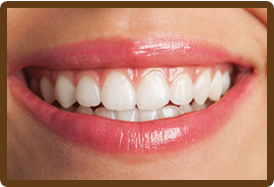PROSTHODONTICS
Prosthodontics is the specialized field of dentistry concerned with diagnosing, planning and executing complex restorative and cosmetic treatment.
There are many reasons why Dr. Trujillo may recommend a consultation by a prosthodontist. These include, but are not limited to:
- Creation of partial or full sets of dentures.
- Desire to whiten the teeth or improve the aesthetics of the smile.
- Filling gaps created by one or more missing teeth.
- Interest in dental implants.
What treatments can the prosthodontist perform?
Prosthodontic treatments are designed to be functional, long lasting and pleasing to the eye. These procedures can only be completed on generally healthy teeth. Issues like gum disease need to be controlled before prosthodontic treatments can begin.
There are an ever-increasing number of hi-tech prosthodontic treatments available including the following:
Dental Implants – Implants are designed to replace the natural teeth in the best possible way. Titanium roots are implanted in the jawbone in the same way as natural tooth roots. Implants look and feel the same as natural teeth.
Dental Veneers – Veneers are porcelain/ceramic covers that are bonded to the natural teeth. Veneers can instantly solve problems like uneven teeth, stained teeth, and chips and damage caused by general wear and tear.
Dental Crowns – Prosthetic crowns are generally made from porcelain, metal or a combination of the two. They have been designed to mimic the natural crown (surface of the tooth) and can last for up to a decade, and possibly longer.
Dental Bridges – Conventional and cantilever bridges are used to support a prosthetic tooth. The natural teeth can support the bridge if they are in good condition, or dental implants may be used as anchors.
Complete Dentures – A complete set of dentures can be created for people who have no teeth due to gum disease or trauma. Complete dentures restore functionality to the mouth and make chewing and speaking easier.
Partial Dentures – Where many teeth have been lost, removable or fixed partial dentures can prove to be an excellent option. They enhance the aesthetics of the smile in addition to improving chewing abilities.
What other problems can a prosthodontist treat?
In addition to performing the treatments described above, the prosthodontist is also adept at treating problems with the jaw (TMJ), alleviating severe snoring, managing sleep apnea, and reconstructing the teeth following oral cancer treatments. Generally, the prosthodontist works in combination with other dental health professionals to ensure the best possible restorative results are achieved.
If you have questions or concerns about prosthodontics, please ask Dr. Trujillo.
Dental implants are a great way to replace missing teeth and also provide a fixed solution to having removable partial or complete dentures. Implants provide excellent support and stability for these dental appliances.
Dental implants act as artificial roots (usually titanium) that are placed into the upper or lower jaw bone. Dr. Trujillo works with several oral surgeons and periodontists that surgically place the implant. Then, after the implant becomes stable in the bone, Dr. Trujillo can restore the implant screw with a restoration to look like a natural tooth. Teeth attached to implants are very natural looking and often enhance or restore the patient’s smile!
Dental implants are very strong, stable, and durable and will last many years, but on occasion will have to be re-tightened or replaced due to normal wear.
Reasons for dental implants:
- Replace one or more missing teeth without affecting adjacent teeth.
- Resolve joint pain or bite problems caused by teeth shifting into missing tooth space.
- Restore a patient’s confident smile.
- Restore chewing, speech, and digestion.
- Restore or enhance facial tissues.
- Support a bridge or denture, making them more secure and comfortable.
What does getting dental implants involve?
The process of getting implants requires a number of visits over several months.
X-rays and impressions (molds) are taken of the jaw and teeth to determine bone, gum tissue, and spacing available for an implant. While the area is numb, the implant will be surgically placed into the bone and allowed to heal and integrate itself onto the bone for up to six months. Depending on the type of implant, a second surgery may be required in order to place the “post” that will hold the artificial tooth in place. With other implants the post and anchor are already attached and placed at the same time.
After several weeks of healing the artificial teeth are made and fitted to the post portion of the anchor. Because several fittings may be required, this step may take one to two months to complete. After a healing period, the artificial teeth are securely attached to the implant, providing excellent stability and comfort to the patient.
Dr. Trujillo will provide care instructions when your treatment is completed. Good oral hygiene, eating habits, and regular dental visits will aid in the life of your new implant.
Veneers are very thin pieces of durable, tooth shaped porcelain that are custom made (for shape and color) by a professional dental laboratory. They are bonded onto the front of teeth to create a beautiful and attractive smile.
Veneers can completely reshape your teeth and smile.
As with most dental restorations, veneers are not permanent and may someday need replacement. They are very durable and will last many years, giving you a beautiful long lasting smile.
Reasons for porcelain veneers:
- Cosmetically, to create a uniform, white, beautiful smile.
- Crooked teeth.
- Misshapen teeth.
- Severely discolored or stained teeth.
- Teeth that are too small or large.
- Unwanted or uneven spaces.
- Worn or chipped teeth.
What does getting porcelain veneers involve?
Getting veneers usually requires two visits to complete the process, with little or no anesthesia required during the procedure. The teeth are prepared by lightly buffing and shaping the surface to allow for the thickness of the veneer. A mold or impression of the teeth is taken and a shade (color) will then be chosen by you and Dr. Trujillo.
On the second visit the teeth will be cleansed with special liquids to achieve a durable bond. Bonding cement is then placed between the tooth and veneer and a special light beam is used to harden and set the bond.
Dr. Trujillo will provide care instructions for veneers. Proper brushing, flossing and regular dental visits will aid in the life of your new veneers.
A crown (or cap) is a covering that encases the entire tooth, restoring it to its original shape and size. A crown protects and strengthens tooth structure that cannot be restored with fillings or other types of restorations.
Although there are several types of crowns, porcelain or ceramic (tooth colored) are the most popular. They are highly durable and will last many years, but like most dental restorations, they may eventually need to be replaced. Porcelain and ceramic crowns are made to match the shape, size, and color of your teeth giving you a natural, long-lasting beautiful smile.
Reasons for crowns:
- Broken or fractured teeth
- Cosmetic enhancement
- Decayed teeth
- Fractured fillings
- Large fillings
- Tooth has a root canal
What does getting a crown involve?
In many instances, with all-ceramic crowns, the crown can be completed in one appointment. Sometimes a crown procedure may require 1 to 2 appointments. Your first appointment will include taking highly accurate molds (or impressions) that will be used to create your custom crown. A mold will also be used to create a temporary crown which will stay on your tooth for approximately two weeks until your new crown is fabricated by a dental laboratory.
While the tooth is numb, Dr. Trujillo will prepare the tooth by removing any decay and shaping the surface to properly fit the crown. Once these details are accomplished, your temporary crown will be placed (if this is a 2-appointment procedure) with temporary cement and your bite will be checked to ensure you are biting properly.
At your second appointment your temporary crown will be removed, the tooth will be cleaned, and your new crown will be carefully placed to ensure the spacing and bite are accurate.
Dr. Trujillo will provide care instructions and encourage you to have regular dental visits to check your new crown.
A denture is a removable dental appliance replacement for missing teeth and surrounding tissue. They are made to closely resemble your natural teeth and will enhance your smile.
There are two types of dentures – complete and partial dentures. Complete dentures are used when all of the teeth are missing. Partial dentures are used when some natural teeth remain. A partial denture not only fills in the spaces created by missing teeth, it prevents other teeth from shifting.
A complete denture may be either “conventional” or “immediate.” A conventional type is made after the teeth have been removed and the gum tissue has healed. Immediate dentures are made in advance of extractions of remaining teeth and immediately placed after the teeth are removed, thus preventing the patient from having to be without teeth during the healing process. Once the tissues shrink and heal, adjustments will have to be made to help the denture fit better.
Dentures are very durable appliances and will last many years, but may have to be remade, repaired, or readjusted due to normal wear.
Reasons for dentures:
- Complete Denture – Loss of all teeth in an arch.
- Partial Denture – Loss of several teeth in an arch.
- Enhancing smile and facial tissues.
- Improving chewing, speech, and digestion.
What does getting dentures involve?
The process of getting dentures requires several appointments, usually over several weeks. Highly accurate impressions (molds) and measurements are taken and used to create your custom denture. Several “try-in” appointments may be necessary to ensure proper shape, color, and fit. At the final appointment, Dr. Trujillo will precisely adjust and place the completed denture, ensuring a natural and comfortable fit.
It is normal to experience increased saliva flow, some soreness, and possible speech and chewing difficulty, however this will subside as your muscles and tissues get used to the new dentures.
Dr. Trujillo will provide care instructions for your new dentures. Proper cleaning of your new dental appliance, good oral hygiene, and regular dental visits will aid in the longevity of your new dentures.
A dental bridge is a fixed (non-removable) appliance and is an excellent way to replace missing teeth.
There are several types of bridges. You and Dr. Trujillo will discuss the best options for your particular case. The “traditional bridge” is the most popular type and is usually made of porcelain fused to metal. This type of bridge consists to two crowns that go over two anchoring teeth (abutment teeth) and are attached to pontics (artificial teeth), filling the gap created by one or more missing teeth.
Dental bridges are highly durable and will last many years, however they may need replacement or need to be re-cemented due to normal wear.
Reasons for a fixed bridge:
- Fill space of missing teeth.
- Maintain facial shape.
- Prevent remaining teeth from drifting out of position.
- Restore chewing and speaking ability.
- Restore your smile.
- Upgrade from a removable partial denture to a permanent dental appliance.
What does getting a fixed bridge involve?
Getting a bridge usually requires two or more visits. While the teeth are numb, the two anchoring teeth are prepared by removing a portion of tooth structure to allow for a crown. Next, a highly accurate impression (mold) is made which will be sent to a dental laboratory where the bridge will be fabricated. In addition, a temporary bridge will be made and worn for several weeks until your next appointment.
At the second visit, you permanent bridge will be carefully checked, adjusted, and cemented to achieve a proper fit. Occasionally Dr. Trujillo may only temporarily cement the bridge, allowing your teeth and tissue time to get used to the new bridge. The new bridge will be permanently cemented at a later time.
Dr. Trujillo will provide care instructions at the conclusion of the procedure. Proper brushing, flossing and regular dental visits will aid in the life of your new permanent bridge.















